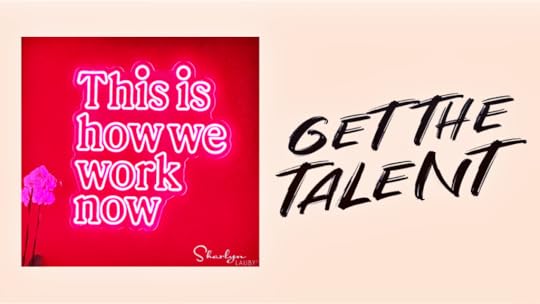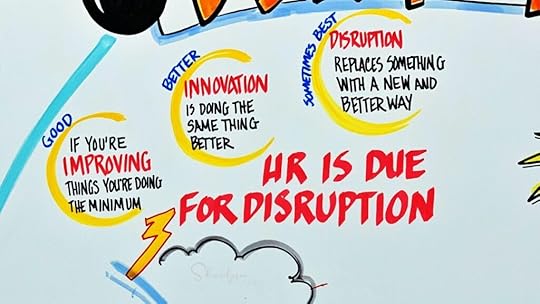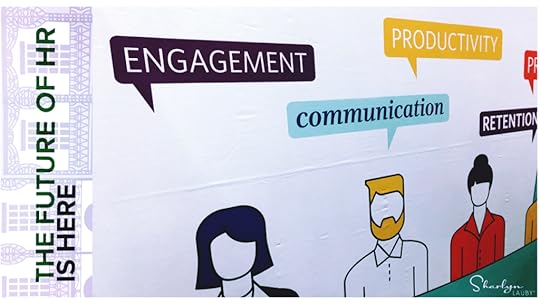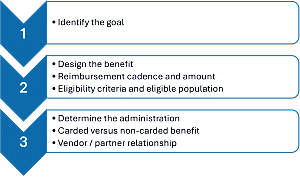Sharlyn J. Lauby's Blog, page 25
March 14, 2024
Organizations: Start Thinking About the Connected Customer

Estimated reading time: 3 minutes
One of the conversations that frustrates me is the one about generations. Mainly because a lot of people get the generation conversation wrong. They assume that because you were born in a certain year and fall into a generational date range like Boomer, Gen X, or Millennial that you’re a certain type of person.
Granted, some of the conversations about generations are true. If you were born before the launch of the iPhone, then you might remember these things called pagers. Or you might remember when airlines printed paper tickets instead of using your watch to board a plane. That makes sense. New things are invented all the time.
What frustrates me is the “if you’re a Millennial, you’re confident with technology”. Like Gen X and Boomers can’t be confident with technology. Or “if you’re Gen X, you’re pragmatic”. Like no one else can be pragmatic.
All that being said, I do realize that the conversation about generations doesn’t seem to be going away, so I wanted to share with you a new generation: Gen C, also known as the connected customer. I read about this concept on Brian Solis’ blog. Brian is the head of global innovation at Service Now.
What was interesting about Generation C, the connected customer, is that it wasn’t age related. Gen C is about technology and the role technology plays in our lives. According to Pew Research:
97% of Americans own a cellphone of some kind.85% of Americans own a smartphone.77% of U.S. homes have broadband subscriptions.From a business perspective, organizations need to think about their consumers (obviously). The question becomes are they thinking about them in terms of being “connected” and what that means for the customer experience.
The same is true for the “unconnected customer”. Does the organization have unconnected customers? What does that mean to the organization and its future plans? Let’s say the organization is a small retail operation. Most of their customers come into a physical store. But the organization wants to expand and have a greater online presence and get into e-commerce. How can the organization do that and keep customer loyalty?
Now take this down to the employee level. As more people rely on technology in their personal lives, they will expect their work experience to be comparable. Human resources departments have to think about their candidate and employee experiences. What interactions make sense to take place online, and which ones should be done in person? Like the rest of the organization, HR has to think about the unconnected candidate and employee. What kind of experience will they get?
The concept of Generation Connected got me thinking about the role of technology. Are organizations (and individuals) still stuck on the “old people don’t know tech” thinking? And if they are, is that kind of generational thinking holding you and the organization back? Technology is a great thing and it’s evolving all the time. Which means that at some point in the near future, we will all have exposure to modern technologies…and we will expect organizations to realize that.
Image capture by Sharlyn Lauby while trying to connect with pie in Reykjavík, Iceland
The post Organizations: Start Thinking About the Connected Customer appeared first on hr bartender.
March 12, 2024
Educate Employees to Practice Better Cybersecurity

Estimated reading time: 4 minutes
As you may know, Mr. Bartender and I are fans of the Marvel Cinematic Universe (MCU). Lately, we’ve been getting caught up on older episodes of the show Jessica Jones. One of the episodes we watched recently showed private-investigator Jessica breaking into a morgue to gather information about someone and she needed to access the computer.
At first, she starts cursing that she can’t get the information she needs because the computer is password-protected. Then she looks up to find – yep, you guessed it – the password was on a sticky note next to the computer screen.
Of course, we can laugh about it … this is superhero television (and who breaks into a morgue to hack a computer anyway). But how many places today still use the “password on a sticky note” approach to technology? Honestly, it’s time for everyone to take cybersecurity seriously.
According to TechReport, 88% of security threats occur due to human error. I’m sure a lot of that human error is simply not knowing good cybersecurity practices. Cybercrime has a significant impact on organizations and the economy. It’s predicted to reach $10.5 trillion dollars by next year (and that’s not a typo – trillion).
One of the statistics that really stuck out for me in the article was that it can take up to 277 days to discover, identify, and contain a data breach. How many times do we click on a link and immediately think “Hmmm…should I have done that? Well, nothing appears to be wrong, so it must have been okay.” The reality is … maybe not.
The reason I’m bringing this up is because the Society for Human Resource Management (SHRM) allowed me to preview a new program titled “Cyber Security: Self Defense in the Digital Age”. It’s a 30-minute session that outlines everyday steps that we can take to practice better cybersecurity.
The program is narrated by Jesse Goldhammer from the University of California’s Berkeley School of Information and Center for Long-Term Cybersecurity. Goldhammer does a great job of conveying highly technical information in a casual manner. The session provides tips that serve as good reminders as well as new security information. The program also includes a quiz at the end for learning reinforcement.
I know a lot of companies make employees watch some sort of cybersecurity video if they click on a phishing email. But as I was watching this program it occurred to be that it might be better to take a proactive approach and have employees view something that shares best practices versus watching something after you have already made a mistake.
Given the organizational impact that cybersecurity threats can have, this is something human resources and learning professionals should educate themselves on. If an organization is experiencing a lot of turnover, it’s possible that new employees don’t know the organization’s cybersecurity protocols. Honestly, it’s not their fault.

Cybersecurity is also a topic that would be perfect for orientation or onboarding. Give employees the education they need to practice good cybersecurity from the start.
And if the organization already has a cybersecurity program in place, consider a regular schedule of refresher training that serves to heighten an employee’s awareness. Whether we want to admit it or not, we’ve all found ourselves in a place where we’re busy, frustrated, and the last thing we want to do is set up two-factor authentication for some software. But we also know that it’s the right thing to do.
In the 2023, Voice of the Chief Information Security Officer (CISO) report, 68% of CISOs felt their organization was at risk of a material cyberattack (up from 48% the year prior). On the flip side, 61% felt unprepared to deal with a cyberattack (up from last year’s 50%). Organizations cannot afford to sit back and say, “Oh, we’re not a target for hackers. That happens to big, high-profile companies.” These days, that’s simply not true.
Because human error plays a role in cybersecurity, human resources departments should be a part of the conversation. That means educating ourselves so we can help the organization find good programs to educate employees.
Image captured by Sharlyn Lauby after the SHRM Annual Conference in Las Vegas, NV
The post Educate Employees to Practice Better Cybersecurity appeared first on hr bartender.
March 10, 2024
10 Work Skills Every Employee Should Have Today

Estimated reading time: 4 minutes
The business world is constantly changing, which means work related skills are changing as well. I thought it might be productive to share a list of skills every employee should have. Regardless of your job title, this is a list of skills that companies expect everyone to possess.
Some people might say this list is basic – and it is. That’s exactly the point. I regularly hear frustration from recruiters that candidates don’t have these skills.
Customer Service – Whether you work in the goods or services sector, understanding the value of customers is essential. This includes the proper way to greet customers, remembering their name, and answering customer inquiries. Communication (written and verbal) – You don’t have to speak professionally or write books. Employees do need to know basic grammar and sentence construction. And when you have doubts, know how to look rules up. There are great resources available like ”The Elements of Style” by William Strunk, Jr. and E.B. White. Technology – This is related to both hardware and software. Organizations today expect employees to know how to apply for a job online, participate in a video conference, and take computer-based training. They also expect employees to have introductory word, spreadsheet, and presentation processing skills.Data, Metrics, and Analytics – Employees need to have some math skills. We’re not talking algebra or trigonometry. Employees should know basic arithmetic and statistics so when they are presented with data they know how to use it to solve problems. Research and Information Gathering – This ties into the previous point about data and problem solving. In today’s world, we have to figure some stuff out on our own. Whether it’s searching the internet to troubleshoot a problem we’re having or collecting accurate data to calm an unhappy customer. Problem Solving – Employees need to be able to do critical thinking, reasoning and problem solving on their own. Other people cannot solve all our problems. Find a problem-solving model that works for you. Organizational Skills – I’m going to lump planning and scheduling into this category as well. Everyone has multiple things going on in their lives. We all have to find a method for keeping a list, putting it on a calendar, or whatever. But forgetting stuff and missing due dates isn’t an option.Empathy – By now, we all understand that empathy is not sympathy. But empathy can be very difficult to learn. It’s a key component to customer service, effective communications, and teamwork.Teamwork – Speaking of teamwork, no matter who we are and what job we have, it’s impossible to do it alone. Employees must be able to work with others. This means communicating effectively, empathizing with others, and learning from them. Virtual workers are not exempt from this.Learning – Being a lifelong learner is not just a workplace slogan. It’s a reality. Today’s workplaces require us to continuously learn new skills. Employees should be open to new learning experiences, aware of how they prefer to learn, and prepared to articulate their learning style to management.So, there’s the list. Now let’s talk about how to use it. A quick career development exercise for anyone: For each of these skills, rate yourself on a scale of 1-10 (1=very little knowledge to 10=consider yourself to be an expert). Any area you’ve rated yourself less than a 5 might be worth some focus. You can develop skills by doing three things.
Reading – books, blogs, magazines, or online content
Listening – podcasts, webinars, or attending conferences
Doing – volunteering for a task or practicing a skill during training
Over time, this list might change. Or there will be a new aspect to a skill like I could see technology being a skill for a very long time but the types of hardware and software that employees need to know changing. The key is to regularly take inventory of your skills and set goals to keep your skills relevant.
The post 10 Work Skills Every Employee Should Have Today appeared first on hr bartender.
March 7, 2024
5 Pieces of Advice for HR Consultants from HR Consultants

Estimated reading time: 7 minutes
We often talk about how organizations need to think about adding a “borrow” strategy to their recruiting efforts. A borrow strategy is intentionally, strategically partnering with freelancers, contractors, and consultants to get work done.
But we haven’t talked much about what this means for the contractor / consultant who does the work. That’s what today’s reader note is all about.
I’m a human resources professional with a MBA and both the SPHR and SHRM-SCP certifications. I’ve been in some different HR roles, but they do not equate to much experience. Currently, I have a very small, super small staffing firm. It’s not enough to pay our bills, so I have frequently found consulting jobs to help sustain us.
I’m at a place financially where I need to do that again but I’m looking for ways to increase my business offerings and not have the need to look for outside employment. What are some things that I should consider when trying to consult full-time?
As you probably know, I’m a human resources consultant. Been doing it for over twenty years. It’s the best job ever. But I will also be the first to admit that it’s not for everyone. And I couldn’t do what I do today if I hadn’t spent time gaining real life human resources knowledge, skills, and abilities as an in-house HR professional.
But I didn’t want you to just walk away with just my experience. So, I reached out to a few colleagues who also do consulting work in the human resources space. I asked them to share one piece of advice for a new consultant and here’s what they said:

With over 30 years in HR, Lisa I. Perez, SPHR, SHRM-SCP is founder of HBL Resources, Inc. and a USA Today bestselling author . She’s been recognized with two 2020 American Business Awards® Silver Stevie Awards for Entrepreneur and Human Resources Professional of the Year. Originally, from Brooklyn, NY, she is a wife, mom, grandma, and considers herself a craft geek.
It’s critical that you take the time and effort to prepare a thorough and well thought out business plan which is essential for anyone starting out as a consultant. This document becomes a living document that should be used routinely to ensure you are on track, revise and update as necessary but also that you execute on your vision for your business. It really will serve as your roadmap, helping you define your goals and strategies to achieve them.
Think big picture for your business and as Steven Covey says, begin with the end in mind so be sure to include all the dreams you have for your business. Additionally, a business plan can help you secure potential funding or lines of credit to support you as you grow your revenues. A great resource to get this accomplished at no cost is to locate your local SCORE Chapter and request a mentor.

Jess Miller-Merrell, founder of Workology.com , is a former executive HR leader turned thought leader and entrepreneur focused on sharing resources and stories to help elevate the workplace, employees, and business leaders. Her newest book is “ Digitizing Talent: Creative Strategies for the Digital Recruiting Age ”published by SHRM in 2023.
For anyone starting out as a human resources consultant, the one thing I would suggest is to prioritize building a strong network and relationships within the HR community and broader business world. HR consulting is a unique skill set, but it depends on relationships almost entirely. This doesn’t mean dive-bombing your LinkedIn network with messages, but instead focus on events (in-person or online) and use them not only as an opportunity to learn, but a way to build connections with people in the industry.

Recently, we had a posting in my Recruiters Online Facebook group that cold calling is 90% mindset and I wholly agreed . But other experienced and successful salespeople said mindset gets you on the phone, but sales skills deliver the orders. If you are a consultant in your own business, you must be able to bring in the clients. Business development is key, and my belief is that boldness is the one thing that you need to get on the phone and make presentations comfortably.

Tim Sackett, SPHR, SHRM-SCP, CEO of HRUTech.com and author of “The Talent Fix, Vol. 2” coming out in April 2024.
The one thing I would do is do two things! First, you must create an easy way for people to write you a check. Do not underestimate how difficult this is. Most new consultants have all this brilliant knowledge and can help their potential clients but then never tell the client this is how we will work with each other.
The best example of this comes from a friend of mine whose grandmother sold door-to-door in downtown Detroit in the 1950s! In those days, selling door to door, you were selling to housewives. So, she sold 3 things: a cooked chicken the ladies could put on the table that day. Stockings the ladies needed for church and maybe bought every other week or so. And a fur coat, which every lady would dream of but almost could never afford. The question you must ask yourself is, what is your ‘chicken’? What little thing can you do for your clients that will get them to sign that contract easily and write you that small check? Getting them to write you that check changes how they see you as a professional. They are now paying for your services. Do not give yourself away for free. Find something they want that isn’t big but they are willing to pay for. Then once they are a paying client, upsell them to your ‘fur coat’!
What’s the second thing? Be prepared to mostly do business development as a consultant. 20% of your time will be consulting. The other 80% will be selling your services. The biggest failure I see consistently with consultants is they underestimate how difficult business development will be.

You will face the challenges of working in and on the business. Every consultant does. My greatest learnings from 24 years of consulting and serving clients and people with Centennial and the Talent Magnet Institute are:
Always remember that clients are people. You are entering the people business, and being confident and comfortable with yourself, being emotionally healthy personally, and being physically and mentally healthy personally will serve you well and those you work with. People, systems, and businesses have challenges, wants, desires and needs. Being present, supportive, and yet humbly confident is very important. And, Determine what you are best at, and this may lead you to stay entrepreneurial or to join a team and be at your highest and best.I want to extend a huge thanks to Mike, Tim, Animal, Jessica, and Lisa for sharing their experience. One of the things that I thought was interesting was how my conversations with them were all one-on-one, they painted a very realistic picture of consulting life. To summarize:
Have a plan.Build a network.Know how to sell.Make it easy for people to give you money.Take care of yourself.These pieces of advice apply whether you’re an HR consultant or a consultant in another field.
Many individuals have a goal to become a consultant. They might want to do this for a variety of reasons – flexibility, location independence, money, etc. Regardless of the reason, it’s important to spend some time thinking about how to be a consultant. Because it is a job.
Image captured by HR Consultant Sharlyn Lauby at the SHRM Annual Conference in Las Vegas, NV
The post 5 Pieces of Advice for HR Consultants from HR Consultants appeared first on hr bartender.
March 5, 2024
4 Things Every Employer Should Know About Mandatory Employee Handouts

Estimated reading time: 5 minutes
(Editor’s Note: Today’s article is brought to you by our friends at Poster Guard â Poster Compliance Service from HRdirect , the leading labor law poster service that gets your business up to date with all the required federal, state, and local labor law postings, and then keeps it that way – for an entire year. Enjoy the article!)
There are two different types of mandatory employee notifications: labor law posters and employee handouts. I recently shared an article about three different employee groups with unique labor law posting requirements and one of those groups was remote workers.
It occurred to me that because there are two types of mandatory employee communications, it’s possible that organizations might overlook employee handouts thinking they’ve got it covered with labor law posters. So, let’s take a high-level look at mandatory employee handouts.
Mandatory handouts are legal notifications, typically issued by government agencies. Common examples include Family and Medical Leave (FMLA), Workers’ Compensation, and sexual harassment in the workplace. These notifications are required at a federal, state, and local level. In addition, government agencies might require notifications in multiple languages.These employee handouts are in addition to any labor law poster requirements for your workplace. This is what makes mandatory employee notifications so challenging. Some laws require only postings, some require postings and handouts, and others only handouts. It’s important to know the requirements as they pertain to your organization.Many required handouts are distributed to employees at the time of hire during orientation. However, some handouts are “event driven”, meaning that they must be distributed at the time of the event. For instance, Family and Medical Leave notifications should be provided to the employee when they are requesting leave.Also remember current employees need to be notified as well. When new notifications are required, organizations should start giving new hires those new required notifications, BUT we can’t forget about existing employees. They need to be notified about the new or changed requirements as well. Keep in mind that some government agencies will require that notifications are acknowledged (i.e. signed) by the employee.The good news is that some government agencies do offer free downloads of these employee handouts. In those situations, HR can simply download the document. That’s not the issue.

The not-so-good news is that there’s no government one stop shop that will tell you everything you’re required to do. According to Lillian Chavez, Esq., managing legal research attorney at ComplyRight, there are “across the nation, more than 400 different federal and state notices that employers must distribute based on different triggering events. In a state like California, there can be up to 32 employee notices issued by up to five different agencies for compliance”.
Let me add to Lillian’s comment that more often than not agencies don’t notify employers of changes. So, organizations not only need to know where to look for the legal requirements, they have to regularly go back and double check to ensure they maintain compliance.
One more thing. There are instances where government agencies do not offer templates or free downloads. Organizations are responsible for creating the handout on their own and I don’t have to tell you what that means. Human resources is responsible for everything that comes with designing the new form – researching the legal guidelines, creating the document, getting legal approvals, communicating the change, etc. Oh, and I know I don’t have to tell you (but I’ll say it anyway) that, if an organization is caught being out of compliance, they are subject to fines, penalties, and legal exposure.
But let’s get back to some more good news. You don’t have do this alone. Our friends at Poster Guard have a Mandatory Employee Handout Service. It was developed by their legal team to help organizations comply with all these handout requirements.

Here’s how the service works. Organizations are provided with electronic access to current federal, state, county, and city handouts, so they can print and deliver, or email them to employees. Poster Guard takes care of monitoring and updating, so organizations will always have the most current information to share with employees. AND they’ve also built some templates that you can use to create your own.
I understand that compliance isn’t always the fun part of being a human resources professional. But it’s essential to the organization and not just from the standpoint of avoiding fines and penalties.
Telling employees their legal rights is simply the right thing to do. The last thing organizations want is to develop a reputation for being an employer that doesn’t operate in good faith. We don’t do that with our customers and we don’t want to do it with employees. It will impact the company’s ability to hire, engage, and retain the best employees, which ultimately impacts the bottom-line.
The post 4 Things Every Employer Should Know About Mandatory Employee Handouts appeared first on hr bartender.
March 3, 2024
Everything HR Needs to Know About Lifestyle Spending Accounts (LSA)

Estimated reading time: 6 minutes
Flexibility is one of the biggest challenges facing organizations today. Employees want flexibility and it’s hard to design workplace programs, policies, and procedures with huge amounts of flexibility. This doesn’t mean we shouldn’t try.
For example, I’ve recently seen some articles about lifestyle spending accounts (LSA) and their ability to offer employees flexibility when it comes to their wellness needs. According to CFO Magazine, 75% of large employers offer LSAs to their employees. So, what are lifestyle spending accounts and why would organizations consider one?
To help us understand this new frontier, I reached out to Lindsay Steckler, health and performance manager for HUB International. She has over 10 years of experience in the wellness industry, and a proven track record in strategic planning, program development, and vendor management. Lindsay consults on wellbeing strategies with a wide variety of organizations, ranging in size from 50 to 15,000 employees. She assists clients with data analytics, business planning, incentive design, and program evaluation.
Lindsay, thanks for being here. Can you briefly explain what lifestyle spending accounts (LSA) are?

[Steckler] Lifestyle Spending Accounts (LSA) are a post-tax benefit that allow employees to purchase wellbeing products and services they value most. Not only are LSAs highly flexible but they can be launched at any time helping employers deliver benefits that appeal to today’s workforce.
Unlike individual vendor discounts, wellness stipends provide choice which increases the benefit’s appeal to a geographically and demographically diverse workforce. When employers partner with a vendor administrator, they can offer inclusive perks without spending a lot of money or HR time to do so.
It’s my understanding that LSAs are different from health spending accounts (HSAs). If organizations already offer HSAs, does adding a LSA make any business sense?
[Steckler] LSAs are distinctly different from Health Spending Accounts (HSAs) or Health Reimbursement Accounts (HRAs) in a few ways:
LSAs are funded by the employer only and as a taxable benefit, they’re not subject to nondiscrimination requirements under the Internal Revenue Service (IRS) code. Per the Affordable Care Act (ACA), HRAs must be ‘integrated’ and only those enrolled in medical coverage can participate. If the employer offers a high deductible health plan (HDHP), the HRA would need to be HDHP compliant.

On the other hand, an LSA can be offered to all employees regardless of enrollment because an LSA cannot include medical care. Otherwise, this would make it an HRA. The employer determines eligible criteria for using the LSA and the employer retains any unused funds.
Why would an employer want to offer a lifestyle spending account? What are the advantages for employees?
[Steckler] There are two primary benefits to employees: flexibility and high value.
Flexibility: The employee determines how they’d like to use the fund (subject to the employer’s criteria).High value: Because of this flexibility, these benefits are highly valued by employees.Benefits to the employer include:
Flexibility: With an LSA, an employer designates after-tax funds to help employees prioritize wellness activities of their choosing for expenses that aren’t covered by traditional benefits. This ensures that employer dollars are being used in a way that employees value while eliminating the need for multiple point solutions.Inclusiveness: Providing flexibility in how the stipend is used allows employers to address benefit gaps and create a more inclusive benefit program.Recruiting and retention tool: Lifestyle benefits like wellness stipends demonstrate to employees that their employer cares about them as a person, not just a worker. Employee appeal: LSAs allow employees to spend on a broad range of wellness needs regardless of where they live or work, making them a great option for supporting the modern workforce.When employees feel cared for, employee engagement and productivity improve, and employers enjoy lower rates of absenteeism and turnover. Additionally, since LSAs are not subject to nondiscrimination rules, an employer can use the funds to recognize service milestones for a specific class of employees (Example: recognizing call center workers after 12 months of employment).
Are there any disadvantages or concerns that employers need to consider when it comes to lifestyle spending accounts?
[Steckler] There are two areas that organizations should be cognizant of when it comes to LSAs: benefit design and compliance.
On the compliance side, LSAs cannot cover ‘medical care’. Beware of expenses such as therapy sessions, chiropractic care, and acupuncture which are likely to be medical care (although not always) and expenses such as vitamins, massages, and gym memberships can also be medical care (though less common). The same applies for travel (medical travel = medical expense).
There’s also the concept of constructive receipt, which is a tax term that determines when an individual has received income. Constructive receipt occurs when an individual obtains income that is not yet physically received but has been credited to the taxpayer’s account and over which they have immediate control. This places heavy restrictions and requirements on employers seeking to give employees a choice between taxable and non-taxable benefits (i.e., offering an LSA or HRA). It can be triggered when an employer allows an LSA balance to rollover and make income taxable in the year it becomes available.
The other consideration is benefit design. Employers need to be aware that structuring the benefit as a reimbursement may unintentionally discriminate against employees who do not have the funds available for the purchase. It’s important to approach the LSA program design strategically: identify the goal, design the benefit, and determine the administration.

Last question. You mentioned earlier that LSAs can be launched at any time. Since many organizations have already done their open enrollment for the year, how easy is it to set up an LSA mid-year?
[Steckler] LSAs can be launched at any time (and therefore terminated at any time, pursuant to administrative vendor contracts).
Most employers set an annual cap of $500-$1,000/per employee. Each LSA can have its own design, eligible population, dollar amounts, funding frequency, reimbursement processes, and spending timeframe. This is a highly utilized benefit this should be considered when organizations budget for this benefit.
I want to extend a huge thanks to Lindsay for sharing her knowledge with us. If you’re looking for ways to make your benefits more flexible, check out HUB International’s Outlook 2024 report. Not only does it talk about ways to strengthen the employee experience, but it outlines opportunities to mitigate risk.
Wellness and wellbeing programs are tremendously popular and for obvious reasons. However, there are recent studies indicating that they might not be as effective as they sound. The reason? They’re not tailored to meet individual needs. What this means is that organizations need to find ways to build more flexibility into their benefits programs. This results in the organization using their resources wisely and employees using the benefit the way they want and need to.
Image captured by Sharlyn Lauby at the SHRM Annual Conference in New Orleans, LA
The post Everything HR Needs to Know About Lifestyle Spending Accounts (LSA) appeared first on hr bartender.
February 29, 2024
3 Reasons an Organization Might Support an Employee Resignation

Estimated reading time: 3 minutes
I was listening to a conversation recently where someone said, “Companies will never let a great employee walk.” I totally get the spirit of the comment. Companies should create a great employee experience, so employees want to stay.
But the truth is that sometimes organizations should let employees tender their resignation. And not in a mean spirited, “Oh they’ll see how good they had it here” kinda way.
In my first HR job, I worked for someone who had been with the company for decades. They were well-liked and respected. They had no intention of leaving. If I wanted to get a promotion, the only way was for me to resign and go someplace else. My boss knew it too. That didn’t stop them from giving me the tools to advance my career and when I was ready to move on, they supported me. Years later, that company called me and asked if I’d consider coming back.
That’s why organizations might consider supporting an employee’s resignation. When they realize that they can no longer offer the employee what they want and/or need. Consider these examples:
(1) The company can’t pay the market rate for the job. I’m not talking about a subjective situation where an employee says, “I want $$$.” What I’m referring to is a situation where the organization realizes that the going market rate for a particular job is $$$, and they only have $$ in their budget.
Most organizations have formalized pay structures. It’s generally frowned upon to operate outside of that structure. It can create inequities that might be perceived as favoritism or even discrimination. It’s really tough when the organization has a great employee that they would love to pay more but the compensation system doesn’t support it.
(2) The organization can’t offer the employee professional development. This is related to the pay issue above. Sometimes organizations can’t pay at market rate, but they are able to offer a lot of perks and benefits, like professional development. An employee might be very willing to stay with an employer because they enjoy the job and the perks, even if the base pay isn’t all that great.
From personal experience, I’ve worked for companies where my base pay wasn’t the highest, but I did have access to free meals, dry cleaning, airline flights, hotel rooms, conference attendance, and more. And I was okay with the arrangement because I liked the job. Which leads me to the last reason …
(3) It’s better for the employee to leave on good terms. There might come a time when the organization realizes that they can’t offer a great employee what they need and/or want. Instead of letting the working relationship turn sour, they support the employee. Because maybe at some point, the employee will want to come back. Or they will refer other employees. Or they will refer customers.
In a perfect world, organizations should create employee experiences that make employees happy to be working there. But there might be times when we have a great employee that, because of internal constraints, we can’t give them what they need and want. The best thing to do might be to support their resignation and part as friends.
Image captured by Sharlyn Lauby while exploring the streets of Fort Lauderdale, FL
The post 3 Reasons an Organization Might Support an Employee Resignation appeared first on hr bartender.
February 27, 2024
Do Organizations Really Want Holacracy Today? [POLL]

Estimated reading time: 2 minutes
I was in a meeting recently with a fellow consultant who said that their clients are looking to move toward holacracy. Honestly, I was a bit surprised. I haven’t heard the term in years.
Holacracy made headlines back in 2014 when Zappos decided they were going to move to this type of structure. Holacracy promotes flatter organizational hierarchies, distributed decision-making, and more self-management.
Don’t get me wrong, I have nothing against holacracy. But realistically, not every organization is a good fit for it nor does every organization want to put in the work to build a good foundation for it. Holacracy requires a lot of training and a redefining of organizational policies, procedures, and guidelines.
But for the organizations that do want holacracy, the benefits can be tremendous. Holacracy can foster more collaboration and teamwork, increase innovation and creativity, and ultimately reduce bureaucracy. All of which lead to greater profits.
Getting back to my comment at the beginning of this article, is it possible that organizations are looking for the benefits of holacracy without actually calling it such? Maybe I’m being too skeptical. I’m curious to know your thoughts.
Let’s do one of our quick, one-question HR Bartender polls. As always, your responses are completely anonymous.
I hope you’ll take the time to respond. We’ll leave the poll open for a couple of weeks and then report the results.
As HR professionals, the organization’s culture focus is important to our work. We talk about it during the recruiting process. It’s part of our employment brand. We also include it in training programs, whether the programs are in-person, online, or during one-on-one meetings. Organizational culture drives the employee experience and plays a key role in retention.
Thanks so much for participating in this poll. I think the results will be very interesting.
Image captured by Sharlyn Lauby while exploring the streets of Los Angelas, CA
The post Do Organizations Really Want Holacracy Today? [POLL] appeared first on hr bartender.
February 25, 2024
Learn How to Use Silence in Your Communication

Estimated reading time: 3 minutes
I saw a posting on LinkedIn recently that said, “Don’t be the person at the meeting with nothing to say.” In thinking about it, I thought the comment should be “Don’t be the person at the meeting with nothing valuable to say.”
There are a lot of people who go to meetings and spend incredible amounts of time talking and don’t say anything of value. Personally, I think it’s okay to have nothing to say. The key is using silence to your advantage.
Being able to communicate well is important. When it comes to communication, we often talk about being able to communicate succinctly and clearly. We talk about the value of listening. But one aspect to communication that we don’t discuss often enough is silence.
Silence can be a useful tool in communications. We’re not talking creepy moments of silence that last for eons. Think of this as just a natural pause in the conversation.
Silence can help us reduce the “ums”. Many of us pepper our conversations with “ums”. Often an “um” is a way to fill in space until we figure out what we want to say. Instead, we can take a brief moment to think out what we want to say and how to say it. This could reduce the number of “ums” we use.
Silence can allow us to collect our thoughts. Sometimes when we’re looking for the right words to express our feelings, taking a moment to gather ourselves can be helpful. Being able to communicate clearly is key to getting our message across.
Silence can allow us to calm our message. If you’re feeling anxious, excited, frustrated, agitated, etc., taking a moment of quiet to collect ourselves can be helpful. This doesn’t mean we have to not express our feelings. In fact, taking a moment of silence could help us communicate our emotions better.
Silence can allow others to join the conversation. For example, a moment of silence during an interview might encourage a candidate to add something to their story. Or during a meeting it might allow a participant to ask a question.
My point is that communication doesn’t involve talking all the time. This is definitely a case of quality over quantity.
We can expand this conversation about silence to the written word as well. Like verbal communications, we need to be able to effectively communicate in writing. We need to be able to comprehend what others write. And we need to know when to put some space – in this case silence – in the conversation.
No, I’m not talking about ghosting someone. But it also doesn’t mean that we need to answer everything right away. For instance, someone can acknowledge an email with a note about when they will respond in full. Maybe they need to research something before they can provide a well thought out reply. Set expectations and manage them appropriately. It can be an effective way to communicate.
Verbal and written communication skills are and will continue to be important. Reminders about effective communications could be timely. Even the best communicators might find a refresher helpful.
Image captured by Sharlyn Lauby after speaking at the SHRM Annual Conference in Washington, DC
The post Learn How to Use Silence in Your Communication appeared first on hr bartender.
February 22, 2024
Job Seeker Wants Their Own Social Media Background Check – Ask #hr bartender

Estimated reading time: 4 minutes
I received a reader question recently that I’ve honestly never heard anyone ask before. It’s about doing your own social media background check.
Hello. I need a referral for a company that will do a normal employment type background check on me. I’m over age 50 and have a lot of good consistent experience. I have been sending my resume around and had a couple call backs but no offers to hire yet. My background is in the construction industry, and I realize that right now the industry is trying very hard to increase workplace diversity because, in my experience, this is historically an old white guy industry.
I don’t know how to set privacy settings on social media. I quit Facebook several years ago but didn’t delete it (just from my phone). Thank you for any referral of background check companies.
Before we talk about the social media piece, there are a couple of other things in this note that I want to address. Please remember that I’m not a lawyer and if you have detailed questions about your specific situation, you should seek professional legal advice.
First, if a job seeker is getting interviews but not job offers, they should do some self-reflection about why. It might be tempting to say it’s because of your gender, age, race, etc. The more likely reason is because there’s a disconnect between what’s on your resume and what you say in the interview.
Right now, there’s approximately 1.4 job openings for each job seeker, which means it’s still very much a candidate’s market. If you’re getting calls, it’s because there is something on your application or resume that looks interesting to the employer. Spend some time thinking about how you’re conveying your knowledge, skills, and experience in the interview. Here are a few articles you might find helpful.
“Why Aren’t You Getting Hired?” from Harvard Business Review
“3 Reasons You Keep Getting Interviews, But No Offers” from The Muse
“Here’s Why You’re Getting Job Interviews – But No Offers” from CNBC
Second, in today’s technology driven world, job seekers need to learn how to properly use social media. Especially if they’re using social media to help them find job opportunities. That includes understanding terms of service and privacy settings. I know it might sound very boring, but it’s absolutely necessary. See if your public library offers some sessions on using social media. Getting a library card is free. And you can also check to see if your library offers LinkedIn Learning for additional classes.
That being said, let’s talk about social media background checks. I’m not aware of any organization where you can preemptively conduct a social media background check on yourself, like checking your own credit score. So, if anyone knows of a company, please drop a note in the comments or email me offline. I’m sure everyone would be interested in that information.
We’ve published a couple of articles on HR Bartender about social media background checks. While they are focused on the employer-side, a job seeker might find them helpful.
Social Media Background Checks: Are They Okay?
According to attorney Heather Bussing, generally, it is okay for potential employers to look at anyone’s public social media. But if the employer obtains the report from someone outside the organization, the Fair Credit Reporting Act (FCRA) applies and you have to give the candidate notice you are doing a background check and get their consent.
Social Media Background Checks: What Employers Should Know
One of the key activities that happens during the selection step is background checks. It might be tempting to simply skip this step to speed up the process, but background checks perform a valuable purpose. For example, an emerging type of background check is the social media background check. I think a lot of organizations are or should be curious to learn more about this specific type of background check. That’s why I asked Bon Idziak, chief compliance and government relations officer at Accurate Background, to give us a primer on the topic.
I’m not exactly sure why this reader wants to conduct a social media background check on themselves. I’m sure we can speculate. But it is an interesting question. Social media has been around for over a decade. But this note is a great reminder for all of us to think about our presence on social media.
Research any social media platforms you want to participate on and understand their terms of service.Establish goals for being on a social media platform. Make sure those goals align with your personal brand. Practice good online security – set up two-factor authentication and know the privacy setting for the platform. Think before you post!Regularly evaluate your participation on social media to ensure your goals are being met.Personally, I believe a lot of people are evaluating their relationship with social media right now. While we might not be able to conduct a social media background check on ourselves, we can step back and ask the question, “What are my goals on social media? And am I accomplishing those goals?”
Image captured by Sharlyn Lauby while exploring the streets of Los Angelas, CA
The post Job Seeker Wants Their Own Social Media Background Check – Ask #hr bartender appeared first on hr bartender.
Sharlyn J. Lauby's Blog
- Sharlyn J. Lauby's profile
- 10 followers



